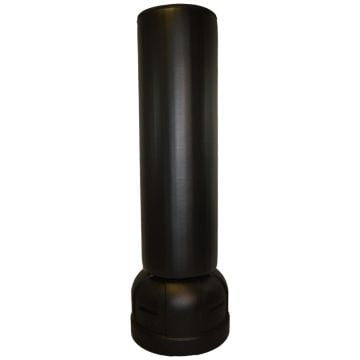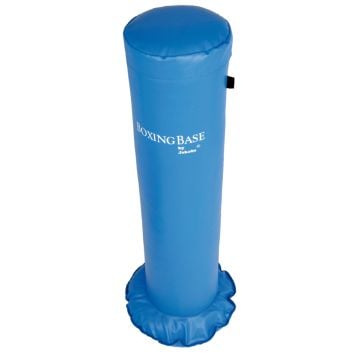Free Standing Punching Bags
The free standing punching bag as the ideal fitness device for at home
Which punching bag is best?
The selection of boxing equipment is very extensive and those who exercise have a wide variety of options when it comes to punching bags for their own home. In addition to the classic hanging punching bag, there is also the punching ball, the punching pear and the inflatable punching bag. Most people automatically associate a punching bag with the bag hanging from the ceiling. However, this hanging punching bag can be relatively complicated and expensive to assemble. In addition, you need a suitable place in your home where the hanging device for the punching bag can be mounted. If you don't want to worry about a ceiling mount by drilling or simply don't have a suitable space for it, a free standing punching bag is the best choice. If the free standing punching bag is upright, there is no need for any special fastening or complex assembly of the training device. The free standing punching bag is therefore a real alternative to the hanging punching bag and also easy and uncomplicated to set up in the living room.
Buying a free standing punching bag - what do you have to consider?
When buying a free standing punching bag, there are several things to consider. The focus is always on the person who uses the punching bag for training. The entire training system must be geared towards the size, weight and strength of each person. The type of boxing training for which the punching bag is used is also decisive for choosing the optimal model.
The following attributes and properties play an important role:
- the size of the system itself
- the weight and diameter of the punching bag
- the flexibility of the spring system
- the material and the filling of the punching bag
- the stand
The size of the system itself
The main focus should primarily be on the size of the punching bag. Not only the overall height of the device, but also the height of the box body, i.e. the cylindrical part on which the blows are directed, plays a decisive role. Both values should always be matched to the size of the person using the training device. As a rule of thumb, the device must be a maximum of ten centimeters larger or smaller than the respective boxer. This is the only way for the trainee to have a correspondingly large striking surface and hit area for his training. Depending on whether kicks are also to be trained, the height of the box body should be adjusted accordingly.
The weight, the diameter and the spring system
The weight of a free standing punching bag depends, like its size, on the boxer training. But not only its size and weight must be considered in this case, but also its power. The heavier the boxer and the stronger his punches, the heavier the punching bag should be. This is the only way to ensure optimal impact and swing behavior of the free standing punching bag. Since the diameter of the punching bag has a direct influence on its weight, this value must also be adapted to the entire training system. But not only weight and diameter are responsible for the vibration behavior of a free standing punching bag. The spring system is also a significant influencing factor. The flexibility of this system is one of the factors that determine whether the sack vibrates strongly or less strongly. Depending on how the boxer's personal preferences and how powerful his punches are, you should choose the best possible overall package of weight, diameter and spring system.
The material and the filling
The outer material of the boxing body and the material with which it is filled are further essential points that influence the punching feedback of the punching bag. The outer material of the punching bag is mostly made of leather, synthetic leather or nylon. The leather version offers the highest quality, but requires more effort in terms of cleaning and care. Artificial leather and nylon, on the other hand, are very easy to care for and also offer high tear resistance. Normal punching bags can be filled with a wide variety of materials, such as textile chips, plastic granulate, corn or sand, so-called sandbags. If the punching bag is upright, foam is the best filler material. In contrast to the other materials, this material does not slide down and the box body can keep its shape and strength constant. In addition, the foam gives very good impact feedback and retains its shape even with harder hits.
The stand
The stand or stand element is largely responsible for the stability and stability of the free standing punching bag. Here, of course, the type of training - for example, whether training for classic boxing or kickboxing - makes the decisive difference. Because the weight of the entire training device must always be borne by the stand element. In addition, the overall stability should be guaranteed by the vibrations of the punching bag when hitting. For this purpose, the base can be filled with water or sand to give it more weight and consequently more stability. If the punching bag is free standing, this is the only way to guarantee safe training without the risk of injury. Here, too, it is important to note: the bigger and heavier the user, the heavier and more stable the base should be.
The boxing dummy for more realistic training
Anyone who values a particularly realistic punching bag as a training partner should practice their punching techniques on a boxing dummy. The boxing body of this device is modelled like a human upper body and not cylindrical like a normal punching bag. In this way, the punches and kicks can be precisely placed on the body of the boxing dummies and the training becomes even more realistic and effective. Such a boxing doll is therefore particularly popular with martial artists such as kickboxers. The targeted placement of the punches on the head and upper body of the boxing doll means you are well prepared for a competition.


